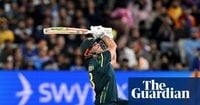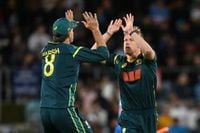The Melbourne Cricket Ground was a cauldron of anticipation on October 31, 2025, as more than 82,400 fans—many draped in blue and gold—packed the stands for the second Twenty20 International between Australia and India. The five-match series, already off to a rain-soaked start in Canberra, finally saw its first result, and what a spectacle it was! Under the floodlights, Australia delivered a dominant four-wicket win, powered by a clinical spell from Josh Hazlewood and a blistering knock by captain Mitchell Marsh.
After Wednesday’s opener was washed out, both teams came into the contest eager to seize momentum ahead of the T20 World Cup next year. Australia’s captain, Marsh, won the toss and wasted no time sending India in to bat, a decision that paid off almost immediately. The pitch had a bit in it, and Hazlewood, ever the craftsman, exploited the conditions with a masterful four-over spell that left India’s top order in tatters.
Hazlewood’s opening salvo set the tone. On the very first ball, he trapped Shubman Gill in front, only for the decision to be overturned on review. But Hazlewood was undeterred. He removed Gill in the third over, caught at mid-off, and then struck twice in his next, sending both Suryakumar Yadav and Tilak Varma back to the pavilion. By the end of the fifth over, India were reeling at 32 for 4, the crowd’s early energy replaced by anxious murmurs. As India captain Suryakumar Yadav later admitted, “The way he bowled in the power play—very difficult to recover from that.”
Sanju Samson fell lbw to Nathan Ellis, and Axar Patel’s run out for just 7 further deepened India’s woes. At 49 for 5, the tourists seemed destined for a sub-100 total. But opener Abhishek Sharma wasn’t ready to roll over. With a mix of audacious strokes and calm shot selection, Sharma counterattacked, reaching his half-century off just 23 balls. He found an able partner in Harshit Rana, and together they stitched a 56-run stand for the sixth wicket, giving the Indian innings some much-needed spine.
Sharma’s knock was a lone hand—68 off 37 balls, studded with eight boundaries and two towering sixes. Rana contributed 35 from 33 deliveries, but wickets continued to tumble at the other end. Xavier Bartlett, after being taken for 17 runs in his second over, bounced back to dismiss both Rana and Shivam Dube. Nathan Ellis returned to trap Sharma lbw in the 19th over, and a run-out off the very next ball ended India’s innings at 125 in 18.4 overs. The final total felt below par, especially on a ground known for its true bounce and fast outfield.
Australia’s chase began with intent. Travis Head and Mitchell Marsh roared out of the blocks, putting on 51 for the first wicket in just five overs. Head’s 28 provided the perfect foil for Marsh, who seemed determined to finish things early. Marsh, in sparkling white-ball form, unleashed a barrage of boundaries and four massive sixes, including one that sailed into the second tier of the Olympic Stand—surely one of the biggest the MCG has seen. He eventually fell for 46 from 26 balls, caught at long off trying to clear the ropes once more.
India’s bowlers managed a few late strikes—Jasprit Bumrah’s double-wicket burst in the penultimate over sparked brief hope, and Kuldeep Yadav accounted for Marsh—but the target was never truly in doubt. Marcus Stoinis kept his cool to hit the winning runs, sealing victory with more than six overs to spare. Australia finished on 126 for 6 in just 13.2 overs, a statement chase that put them 1-0 up in the series.
“Everything feels in a good place, and ready to go,” Hazlewood said after his match-defining spell of 3 for 13. The veteran paceman, who will soon leave the white-ball squad to prepare for the Ashes, showed why he’s regarded as one of the world’s best seamers. His ability to hit a test-match length and generate movement under lights made all the difference, and his performance drew plaudits from both camps.
India, meanwhile, will be left ruing a missed opportunity to build on the momentum from their strong start in the rain-abandoned first match. Youngsters like Abhishek Sharma and Harshit Rana impressed with their composure and power, but the top-order collapse proved fatal. The team’s inability to recover from Hazlewood’s early strikes exposed a fragility that will need addressing before the next clash. With the T20 World Cup looming, these are the kinds of pressure situations that can make or break a campaign.
Beyond the cricket, the night was marked by a somber tribute to Ben Austin, the 17-year-old cricketer who tragically died after being struck by a ball during a net session earlier in the week. Both teams, along with match officials and administrators, wore black armbands in his memory. A minute’s silence was observed before play, and Austin’s image was displayed on the stadium screens as his favorite song played—a poignant reminder of the risks and the camaraderie that bind the cricketing community together.
Looking ahead, the series now moves to Hobart for the third T20I on November 2, with a double-header in Queensland set to follow. Australia, buoyed by their emphatic win and the form of their captain and bowlers, will look to press their advantage. India, on the other hand, have questions to answer—about their batting order, their response to high-quality seam bowling, and their ability to adapt under pressure. The contest is far from over, and with both teams eyeing combinations ahead of the World Cup, every match feels like a dress rehearsal for the big stage.
As the teams prepare for the next battle, fans can expect more fireworks, more tactical intrigue, and—if the opening exchanges are any indication—a series that could go down to the wire. The MCG clash may be in the books, but the real story of this Australia-India rivalry is just getting started.

